|
| |
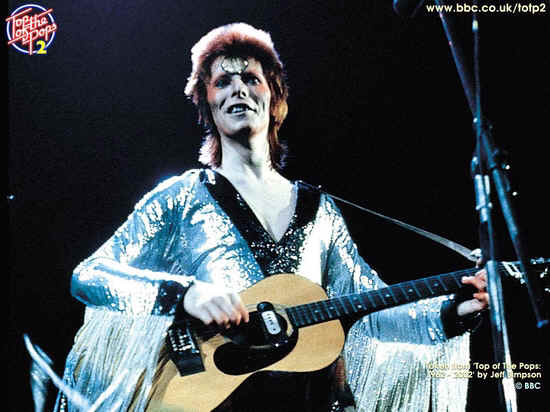
The cliché about David Bowie says he's a musical chameleon, adapting himself
according to fashion and trends. While such a criticism is too glib, there's no denying
that Bowie demonstrated remarkable skill for perceiving musical trends at his peak in the
'70s. After spending several years in the late '60s as a mod and as an all-around
music-hall entertainer, Bowie reinvented himself as a hippie singer/songwriter. Prior to
his breakthrough in 1972, he recorded a proto-metal record and a pop/rock album,
eventually redefining glam rock with his ambiguously sexy Ziggy Stardust persona. Ziggy
made Bowie an international star, yet he wasn't content to continue to churn out glitter
rock. By the mid-'70s, he developed an effete, sophisticated version of Philly soul that
he dubbed "plastic soul," which eventually morphed into the eerie avant-pop of
1976's Station to Station. Shortly afterward, he relocated to Berlin, where he recorded
three experimental electronic albums with Brian Eno. At the dawn of the '80s, Bowie was
still at the height of his powers, yet following his blockbuster dance-pop album Let's
Dance in 1983, he slowly sank into mediocrity before salvaging his career in the early
'90s. Even when he was out of fashion in the '80s and '90s, it was clear that Bowie was
one of the most influential musicians in rock, for better and for worse. Each one of his
phases in the '70s sparked a number of subgenres, including punk, new wave, goth rock, the
new romantics, and electronica. Few rockers ever had such lasting impact.
David Jones began performing music when he was 13 years old, learning the saxophone
while he was at Bromley Technical High School; another pivotal event happened at the
school, when his left pupil became permanently dilated in a schoolyard fight. Following
his graduation at 16, he worked as a commercial artist while playing saxophone in a number
of mod bands, including the King Bees, the Manish Boys (which also featured Jimmy Page as
a session man), and Davey Jones & the Lower Third. All three of those bands released
singles, which were generally ignored, yet he continued performing, changing his name to
David Bowie in 1966 after the Monkees' Davy Jones became an international star. Over the
course of 1966, he released three mod singles on Pye Records, which were all ignored. The
following year, he signed with Deram, releasing the music hall, Anthony Newley-styled
David Bowie that year. Upon completing the record, he spent several weeks in a Scottish
Buddhist monastery. Once he left the monastery, he studied with Lindsay Kemp's mime
troupe, forming his own mime company, the Feathers, in 1969. The Feathers were
short-lived, and he formed the experimental art group Beckenham Arts Lab in 1969.
Bowie needed to finance the Arts Lab, so he signed with Mercury Records that year and
released Man of Words, Man of Music, a trippy singer/songwriter album featuring
"Space Oddity." The song was released as a single and became a major hit in the
U.K., convincing Bowie to concentrate on music. Hooking up with his old friend Marc Bolan,
he began miming at some of Bolan's T. Rex concerts, eventually touring with Bolan,
bassist/producer Tony Visconti, guitarist Mick Ronson, and drummer Cambridge as Hype. The
band quickly fell apart, yet Bowie and Ronson remained close, working on the material that
formed Bowie's next album, The Man Who Sold the World, as well as recruiting Michael
"Woody" Woodmansey as their drummer. Produced by Tony Visconti, who also played
bass, The Man Who Sold the World was a heavy guitar rock album that failed to gain much
attention. Bowie followed the album in late 1971 with the pop/rock Hunky Dory, an album
that featured Ronson and keyboardist Rick Wakeman.
Following the release of Hunky Dory, Bowie began to develop his most famous
incarnation, Ziggy Stardust: an androgynous, bisexual rock star from another planet.
Before he unveiled Ziggy, Bowie claimed in a January 1972 interview with the Melody Maker
that he was gay, helping to stir interest in his forthcoming album. Taking cues from
Bolan's stylish glam rock, Bowie dyed his hair orange and began wearing women's clothing.
He began calling himself Ziggy Stardust, and his backing band - Ronson, Woodmansey, and
bassist Trevor Bolder - were the Spiders from Mars. The Rise & Fall of Ziggy Stardust
and the Spiders from Mars was released with much fanfare in England in late 1972. The
album and its lavish, theatrical concerts became a sensation throughout England, and it
helped him become the only glam rocker to carve out a niche in America. Ziggy Stardust
became a word-of-mouth hit in the U.S., and the re-released "Space Oddity" -
which was now also the title of the re-released Man of Words, Man of Music - reached the
American Top 20. Bowie quickly followed Ziggy with Aladdin Sane later in 1973. Not only
did he record a new album that year, but he also produced Lou Reed's Transformer, the
Stooges' Raw Power, and Mott the Hoople's comeback All the Young Dudes, for which he also
wrote the title track.
Given the amount of work Bowie packed into 1972 and 1973, it wasn't surprising that
his relentless schedule began to catch up with him. After recording the all-covers Pin-Ups
with the Spiders from Mars, he unexpectedly announced the band's breakup, as well as his
retirement from live performances, during the group's final show that year. He retreated
from the spotlight to work on a musical adaptation of George Orwell's 1984, but once he
was denied the rights to the novel, he transformed the work into Diamond Dogs. The album
was released to generally poor reviews in 1974, yet it generated the hit single
"Rebel Rebel," and he supported the album with an elaborate and expensive
American tour. As the tour progressed, Bowie became fascinated with soul music, eventually
redesigning the entire show to reflect his new "plastic soul." Hiring guitarist
Carlos Alomar as the band's leader, Bowie refashioned his group into a Philly soul band
and recostumed himself in sophisticated, stylish fashions. The change took fans by
surprise, as did the double-album David Live, which featured material recorded on the 1974
tour.
Young Americans, released in 1975, was the culmination of Bowie's soul obsession, and
it became his first major crossover hit, peaking in the American Top Ten and generating
his first U.S. number one hit in "Fame," a song he co-wrote with John Lennon and
Alomar. Bowie relocated to Los Angeles, where he earned his first movie role in Nicolas
Roeg's The Man Who Fell to Earth (1976). While in L.A., he recorded Station to Station,
which took the plastic soul of Young Americans into darker, avant-garde-tinged directions,
yet was also a huge hit, generating the Top Ten single "Golden Years." The album
inaugurated Bowie's persona of the elegant "Thin White Duke," and it reflected
Bowie's growing cocaine-fueled paranoia. Soon, he decided Los Angeles was too boring and
returned to England; shortly after arriving back in London, he gave the awaiting crowd a
Nazi salute, a signal of his growing, drug-addled detachment from reality. The incident
caused enormous controversy, and Bowie left the country to settle in Berlin, where he
lived and worked with Brian Eno.
Once in Berlin, Bowie sobered up and began painting, as well as studying art. He also
developed a fascination with German electronic music, which Eno helped him fulfill on
their first album together, Low. Released early in 1977, Low was a startling mixture of
electronics, pop, and avant-garde technique. While it was greeted with mixed reviews at
the time, it proved to be one of the most influential albums of the late '70s, as did its
follow-up, Heroes, which followed that year. Not only did Bowie record two solo albums in
1977, but he also helmed Iggy Pop's comeback records The Idiot and Lust for Life, and
toured anonymously as Pop's keyboardist. He resumed his acting career in 1977, appearing
in Just A Gigolo with Marlene Dietrich and Kim Novak, as well as narrating Eugene
Ormandy's version of Peter and the Wolf. Bowie returned to the stage in 1978, launching an
international tour that was captured on the double-album Stage. During 1979, Bowie and Eno
recorded Lodger in New York, Switzerland, and Berlin, releasing the album at the end of
the year. Lodger was supported with several innovative videos, as was 1980's Scary
Monsters, and these videos - "DJ," "Fashion," "Ashes to
Ashes" - became staples on early MTV.
Scary Monsters was Bowie's last album for RCA, and it wrapped up his most innovative,
productive period. Later in 1980, he performed the title role in stage production of The
Elephant Man, including several shows on Broadway. Over the next two years, he took an
extended break from recording, appearing in Christine F (1982) and the vampire movie The
Hunger (1982), returning to the studio only for his 1981 collaboration with Queen,
"Under Pressure," and the theme for Paul Schrader's remake of Cat People. In
1983, he signed an expensive contract with EMI Records and released Let's Dance. Bowie had
recruited Chic guitarist Nile Rodgers to produce the album, giving the record a sleek,
funky foundation, and hired the unknown Stevie Ray Vaughan as lead guitarist. Let's Dance
became his most successful record, thanks to stylish, innovative videos for "Let's
Dance" and "China Girl," which turned both songs into Top Ten hits. Bowie
supported the record with the sold-out arena tour Serious Moonlight.
Greeted with massive success for the first time, Bowie wasn't quite sure how to react,
and he eventually decided to replicate Let's Dance with 1984's Tonight. While the album
sold well, producing the Top Ten hit "Blue Jean," it received poor reviews and
ultimately was a commercial disappointment. He stalled in 1985, recording a duet of Martha
& the Vandellas' "Dancing in the Street" with Mick Jagger for Live Aid. He
also spent more time jet-setting, appearing at celebrity events across the globe, and
appeared in several movies - Into the Night (1985), Absolute Beginners (1986), Labyrinth
(1986) - that turned out to be bombs. Bowie returned to recording in 1987 with the widely
panned Never Let Me Down, supporting the album with the Glass Spider tour, which also
received poor reviews. In 1989, he remastered his RCA catalog with Rykodisc for CD
release, kicking off the series with the three-disc box Sound + Vision. Bowie supported
the discs with an accompanying tour of the same name, claming that he was retiring all of
his older characters from performance following the tour. Sound + Vision was successful,
and Ziggy Stardust re-charted amidst the hoopla.
Sound + Vision may have been a success, but Bowie's next project was perhaps his most
unsuccessful. Picking up on the abrasive, dissonant rock of Sonic Youth and the Pixies,
Bowie formed his own guitar rock combo, Tin Machine, with guitarist Reeves Gabrels,
bassist Hunt Sales, and his drummer brother Tony, who had previously worked on Iggy Pop's
Lust for Life with Bowie. Tin Machine released an eponymous album to poor reviews that
summer and supported it with a club tour, which was only moderately successful. Despite
the poor reviews, Tin Machine released a second album, the appropriately titled Tin
Machine II, in 1991, and it was completely ignored.
Bowie returned to a solo career in 1993 with the sophisticated, soulful Black Tie
White Noise, recording the album with Nile Rodgers and his now-permanent collaborator,
Reeves Gabrels. The album was released on Savage, a subsidiary of RCA, and received
positive reviews, but his new label went bankrupt shortly after its release, and the album
disappeared. Black Tie White Noise was the first indication that Bowie was trying hard to
resuscitate his career, as was the largely instrumental 1994 soundtrack The Buddha of
Suburbia. In 1995, he reunited with Brian Eno for the wildly hyped, industrial rock-tinged
Outside. Several critics hailed the album as a comeback, and Bowie supported it with a
co-headlining tour with Nine Inch Nails in order to snag a younger, alternative audience,
but his gambit failed; audiences left before Bowie's performance and Outside disappeared.
He quickly returned to the studio in 1996, recording Earthling, an album heavily
influenced by techno and drum'n'bass. Upon its early 1997 release, Earthling received
generally positive reviews, yet the album failed to gain an audience, and many techno
purists criticized Bowie for allegedly exploiting their subculture. hours... followed in
1999.
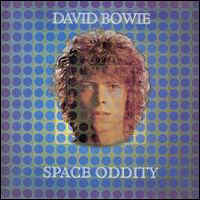
Space Oddity - 1969
Originally released as Man of Words/Man of Music, Space Oddity was David Bowie's first
successful reinvention of himself. Abandoning both the mod and Anthony Newley fascinations
that marked his earlier recordings, Bowie delves into a lightly psychedelic folk-rock,
exemplified by the album's soaring title track. Bowie actually attempts a variety of
styles on Space Oddity, as if he were trying to find the ones that suited him best. As
such, the record isn't very cohesive, but it is charming, especially in light of his later
records. Nevertheless, only "Wild Eyed Boy From Freecloud" and "Memory of a
Free Festival" rank as Bowie classics, and even those lack the hooks or purpose of
"Space Oddity." - Stephen Thomas Erlewine
01 - (5:19) Space Oddity
02 - (6:15) Unwashed And Somewhat Slightly Dazed
03 - (0:45) Don't Sit Down
04 - (2:38) Letter To Hermione
05 - (9:40) Cygnet Committee
06 - (3:27) Janine
07 - (3:03) An Occasional Dream
08 - (4:54) Wild Eyed Boy From Freecloud
09 - (3:24) God Knows I'm Good
10 - (7:12) Memory Of A Free Festival

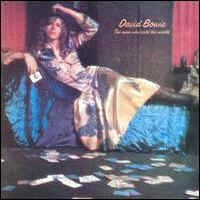
The Man Who Sold The World - 1970
Even though it contained no hits, The Man Who Sold the World, for most intents and
purposes, is the beginning of David Bowie's classic period. Working with guitarist Mick
Ronson and producer Tony Visconti for the first time, Bowie developed a tight, twisted
heavy guitar rock that appears simple on the surface but sounds more gnarled upon each
listen. The mix is off-center, with the fuzz-bass dominating the compressed, razor-thin
guitars and Bowie's strangled, affected voice. The sound of The Man Who Sold the World is
odd, but the music is bizarre itself, with Bowie's bizarre, paranoid futuristic tales
melded to Ronson's riffing and the band's relentless attack. Musically, there isn't much
innovation on The Man Who Sold the World - it is almost all hard blues-rock or psychedelic
folk-rock - but there's an unsettling edge to the band's performance, which makes the
record one of Bowie's best albums. [Rykodisc's 1990 CD reissue includes four bonus tracks,
including the previously unreleased "Lightning Frightening," and the single
"Holy Holy," and both sides of the 1971 "Arnold Corns" single,
"Moonage Daydream" and "Hang On to Yourself," which are early and
inferior versions of songs that would later appear on Ziggy Stardust.] - Stephen Thomas
Erlewine
1 - (8:12) The Width Of A Circle
2 - (5:43) All The Madmen
3 - (3:38) Black Country Rock
4 - (3:58) After All
5 - (3:17) Running Gun Blues
6 - (4:31) Saviour Machine
7 - (4:19) She Shook Me Cold
8 - (4:02) The Man Who Sold The World
9 - (3:42) The Supermen

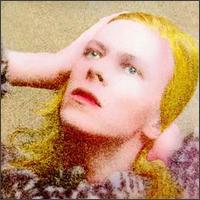
Hunky Dory - 1971
After the freakish hard rock of The Man Who Sold the World, David Bowie returned to
singer/songwriter territory on Hunky Dory. Not only did the album boast more folky songs
("Song for Bob Dylan," "The Bewlay Brothers"), but he again flirted
with Anthony Newley-esque dancehall music ("Kooks," "Fill Your
Heart"), seemingly leaving heavy metal behind. As a result, Hunky Dory is a
kaleidoscopic array of pop styles, tied together only by Bowie's sense of vision: a
sweeping, cinematic mélange of high and low art, ambiguous sexuality, kitsch, and class.
Mick Ronson's guitar is pushed to the back, leaving Rick Wakeman's cabaret piano to
dominate the sound of the album. The subdued support accentuates the depth of Bowie's
material, whether it's the revamped Tin Pan Alley of "Changes," the Neil Young
homage "Quicksand," the soaring "Life on Mars?," the rolling, vaguely
homosexual anthem "Oh! You Pretty Things," or the dark acoustic rocker
"Andy Warhol." On the surface, such a wide range of styles and sounds would make
an album incoherent, but Bowie's improved songwriting and determined sense of style
instead made Hunky Dory a touchstone for reinterpreting pop's traditions into fresh,
postmodern pop music. - Stephen Thomas Erlewine
01 - (3:38) Changes
02 - (3:13) Oh! You Pretty Things
03 - (2:56) Eight Line Poem
04 - (3:55) Life On Mars?
05 - (2:54) Kooks
06 - (5:08) Quicksand
07 - (3:08) Fill Your Heart
08 - (3:58) Andy Warhol
09 - (4:13) Song For Bob Dylan
10 - (3:19) Queen Bitch
11 - (5:24) The Bewlay Brothers


The Rise & Fall Of Ziggy Stardust - 1972
Borrowing heavily from Marc Bolan's glam rock and the future shock of A Clockwork
Orange, David Bowie reached back to the heavy rock of The Man Who Sold the World for The
Rise & Fall of Ziggy Stardust and the Spiders From Mars. Constructed as a loose
concept album about an androgynous alien rock star named Ziggy Stardust, the story falls
apart quickly, yet Bowie's fractured, paranoid lyrics are evocative of a decadent,
decaying future, and the music echoes an apocalyptic, nuclear dread. Fleshing out the
off-kilter metallic mix with fatter guitars, genuine pop songs, string sections,
keyboards, and a cinematic flourish, Ziggy Stardust is a glitzy array of riffs, hooks,
melodrama, and style and the logical culmination of glam. Mick Ronson plays with a
maverick flair that invigorates rockers like "Suffragette City," "Moonage
Daydream," and "Hang Onto Yourself," while "Lady Stardust,"
"Five Years," and "Rock 'n' Roll Suicide" have a grand sense of staged
drama previously unheard of in rock & roll. And that self-conscious sense of theater
is part of the reason why Ziggy Stardust sounds so foreign. Bowie succeeds not in spite of
his pretensions but because of them, and Ziggy Stardust - familiar in structure, but alien
in performance - is the first time his vision and execution met in such a grand, sweeping
fashion. - Stephen Thomas Erlewine
01 - (4:44) Five Years
02 - (3:34) Soul Love
03 - (4:40) Moonage Daydream
04 - (4:15) Starman
05 - (2:58) It Ain't Easy
06 - (3:21) Lady Stardust
07 - (2:47) Star
08 - (2:39) Hang On To Yourself
09 - (3:14) Ziggy Stardust
10 - (3:25) Suffragette City
11 - (3:00) Rock & Roll Suicide

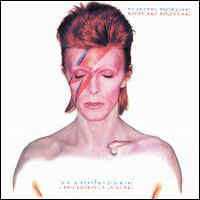
Aladdin Sane - 1973
Ziggy Stardust wrote the blueprint for David Bowie's hard-rocking glam, and Aladdin
Sane essentially follows the pattern, for both better and worse. A lighter affair than
Ziggy Stardust, Aladdin Sane is actually a stranger album than its predecessor, buoyed by
bizarre lounge-jazz flourishes from pianist Mick Garson and a handful of winding, vaguely
experimental songs. Bowie abandons his futuristic obsessions to concentrate on the
detached cool of New York and London hipsters, as on the compressed rockers "Watch
That Man," "Cracked Actor," and "The Jean Genie." Bowie follows
the hard stuff with the jazzy, dissonant sprawls of "Lady Grinning Soul,"
"Aladdin Sane," and "Time," all of which manage to be both campy and
avant-garde simultaneously, while the sweepingly cinematic "Drive-In Saturday"
is a soaring fusion of sci-fi doo wop and melodramatic teenage glam. He lets his paranoia
slip through in the clenched rhythms of "Panic in Detroit," as well as on his
oddly clueless cover of "Let's Spend the Night Together." For all the pleasures
on Aladdin Sane, there's no distinctive sound or theme to make the album cohesive; it's
Bowie riding the wake of Ziggy Stardust, which means there's a wealth of classic material
here, but not enough focus to make the album itself a classic. - Stephen Thomas Erlewine
Disc 1
01 - (4:32) Watch That Man
02 - (5:10) Aladdin Sane
03 - (4:38) Drive-In Saturday
04 - (4:29) Panic In Detroit
05 - (3:03) Cracked Actor
06 - (5:16) Time
07 - (3:32) The Prettiest Star
08 - (3:12) Let's Spend The Night Together
09 - (4:08) The Jean Genie
10 - (3:54) Lady Grinning Soul
Disc 2
01 - (2:47) John, I'm Only Dancing [Sax Version]
02 - (4:09) The Jean Genie [Original Single Mix]
03 - (3:45) Time [Single Edit]
04 - (4:13) All The Young Dudes
05 - (3:22) Changes [Live]
06 - (2:44) The Supermen [Live]
07 - (3:27) Life On Mars? [Live]
08 - (2:41) John, I'm Only Dancing [Live]
09 - (4:12) The Jean Genie [Live]
10 - (4:55) Drive-In Saturday [Live]


Pin Ups - 1973
Perhaps the covers album Pin-Ups was conceived as a breather, a way for David Bowie and
the Spiders From Mars to regroup amid the hysteria of the Ziggy Stardust mania, or perhaps
it was meant as a genuine tribute to Bowie's influences. Either way, Pin-Ups was the first
sign that the Ziggy persona was running out of energy. The album isn't bad - in fact, it's
an energetic, infectious collection of relatively obscure British rock & roll,
R&B, and mod anthems - but the timing of a covers album was odd, suggesting that Bowie
was running out of ideas. On its own, Pin-Ups is quite enjoyable, especially since the
selections are fairly arcane. Bowie relies primarily on songs that never were hits outside
America - even the Kinks, Who, Yardbirds, and Pink Floyd songs were relatively obscure -
which makes the record fascinating. Bowie and the Spiders make songs by the Pretty Things
("Rosalyn," "Don't Bring Me Down"), the Merseys ("Sorrow"),
and the Easybeats ("Friday on My Mind") tough and nervy, occasionally surpassing
the original versions in terms of attitude. So, if Pin-Ups isn't a major entry in Bowie's
catalog, it is fun, even though it's a rather undistinguished final effort from the
Spiders From Mars. - Stephen Thomas Erlewine
01 - (2:22) Rosalyn
02 - (3:10) Here Comes The Night
03 - (2:49) I Wish You Would
04 - (4:13) See Emily Play
05 - (2:29) Everything's Alright
06 - (2:12) I Can't Explain
07 - (2:57) Friday On My Mind
08 - (2:54) Sorrow
09 - (2:06) Don't Bring Me Down
10 - (2:54) Shapes Of Things
11 - (3:13) Anyway, Anyhow, Anywhere
12 - (2:42) Where Have All The Good Times Gone?

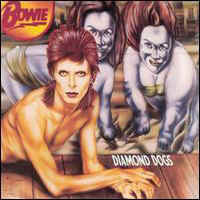
Diamond Dogs - 1974
David Bowie fired the Spiders From Mars shortly after the release of Pin-Ups, but he
didn't completely leave the Ziggy Stardust persona behind. Diamond Dogs suffers precisely
because of this - he doesn't know how to move forward. Originally conceived as a concept
album based on George Orwell's 1984, Diamond Dogs evolved into another one of Bowie's
paranoid future nightmares. Throughout the album, there are hints that he's tired with the
Ziggy formula, particularly in the disco underpinning of "Candidate" and his
cut-and-paste lyrics. However, it's not enough to make Diamond Dogs a step forward, and
without Mick Ronson to lead the band, the rockers are too stiff to make an impact.
Ironically, the one exception is one of Bowie's very best songs - the tight, sexy
"Rebel Rebel." The song doesn't have much to do with the theme, and the ones he
does throw in to further the story usually fall flat. Diamond Dogs isn't a total waste,
with "1984," "Candidate," and "Diamond Dogs" all offering
some sort of pleasure, but it is the first record since Space Oddity where Bowie's reach
exceeds his grasp. - Stephen Thomas Erlewine
01 - (1:09) Future Legend
02 - (6:01) Diamond Dogs
03 - (3:41) Sweet Thing
04 - (2:42) Candidate
05 - (2:34) Sweet Thing (Reprise)
06 - (4:36) Rebel Rebel
07 - (4:04) Rock 'N' Roll With Me
08 - (5:02) We Are The Dead
09 - (3:29) 1984
10 - (3:23) Big Brother
11 - (2:06) Chant Of The Ever Circling Skeletal Family


Young Americans - 1975
David Bowie had dropped hints during the Diamond Dogs tour that he was moving toward
R&B, but the full-blown blue-eyed soul of Young Americans came as a shock. Surrounding
himself with first-rate sessionmen, Bowie comes up with a set of songs that approximate
the sound of Philly soul and disco, yet remain detached from their inspirations; even at
his most passionate, Bowie sounds like a commentator, as if the entire album was a genre
exercise. Nevertheless, the distance doesn't hurt the album - it gives the record its own
distinctive flavor, and its plastic, robotic soul helped inform generations of synthetic
British soul. What does hurt the record is a lack of strong songwriting. "Young
Americans" is a masterpiece, and "Fame" had a beat funky enough that James
Brown ripped it off, but only a handful of cuts ("Win," "Fascination,"
"Somebody up There Likes Me") comes close to matching their quality. As a
result, Young Americans is more enjoyable as a stylistic adventure than as a substantive
record. [The 1991 CD has three bonus tracks, including the terrific outtake "Who Can
I Be Now?."] - Stephen Thomas Erlewine
1 - (5:15) Young Americans
2 - (4:47) Win
3 - (5:48) Fascination
4 - (4:19) Right
5 - (6:34) Somebody Up There Likes Me
6 - (4:33) Across The Universe
7 - (5:06) Can You Hear Me
8 - (4:18) Fame

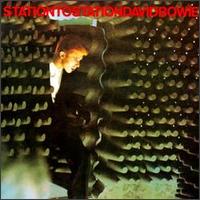
Station To Station - 1976
Taking the detached plastic soul of Young Americans to an elegant, robotic extreme,
Station to Station is a transitional album that creates its own distinctive style.
Abandoning any pretense of being a soulman, yet keeping rhythmic elements of soul, David
Bowie positions himself as a cold, clinical crooner and explores a variety of styles.
Everything from epic ballads and disco to synthesized avant pop is present on Station to
Station, but what ties it together is Bowie's cocaine-induced paranoia and detached
musical persona. At its heart, Station to Station is an avant-garde art-rock album, most
explicitly on "TVC 15" and the epic sprawl of the title track, but also on the
cool crooning of "Wild Is the Wind" and "Word on a Wing," as well as
the disco stylings of "Golden Years." It's not an easy album to warm to, but its
epic structure and clinical sound were an impressive, individualistic achievement, as well
as a style that would prove enormously influential on post-punk. - Stephen Thomas Erlewine
1 - (10:17) Station To Station
2 - (4:02) Golden Years
3 - (6:05) Word On A Wing
4 - (5:35) TVC 15
5 - (6:17) Stay
6 - (6:02) Wild Is The Wind

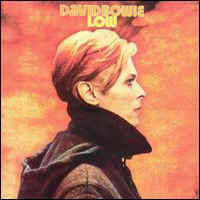
Low - 1977
Following through with the avant-garde inclinations of Station to Station, yet
explicitly breaking with David Bowie's past, Low is a dense, challenging album that
confirmed his place at rock's cutting edge. Driven by dissonant synthesizers and
electronics, Low is divided between brief, angular songs and atmospheric instrumentals.
Throughout the record's first half, the guitars are jagged and the synthesizers drone with
a menacing robotic pulse, while Bowie's vocals are unnaturally layered and overdubbed.
During the instrumental half, the electronics turn cool, which is a relief after the
intensity of the preceding avant pop. Half the credit for Low's success goes to Brian Eno,
who explored similar ambient territory on his own releases. Eno functioned as a conduit
for Bowie's ideas, and in turn Bowie made the experimentalism of not only Eno but of the
German synth group Kraftwerk and the post-punk group Wire respectable, if not quite
mainstream. Though a handful of the vocal pieces on Low are accessible - "Sound and
Vision" has a shimmering guitar hook, and "Be My Wife" subverts soul
structure in a surprisingly catchy fashion - the record is defiantly experimental and
dense with detail, providing a new direction for the avant-garde in rock & roll. -
Stephen Thomas Erlewine
01 - (2:49) Speed Of Life
02 - (1:55) Breaking Glass
03 - (2:26) What In The World
04 - (3:06) Sound And Vision
05 - (3:36) Always Crashing In The Same Car
06 - (2:59) Be My Wife
07 - (2:58) A New Career In A New Town
08 - (6:27) Warszawa
09 - (3:50) Art Decade
10 - (3:31) Weeping Wall
11 - (5:45) Subterraneans
12 - (3:19) Some Are
13 - (3:41) All Saints
14 - (4:45) Sound And Vision

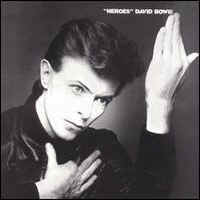
Heroes - 1977
Repeating the formula of Low's half-vocal/half-instrumental structure, Heroes develops
and strengthens the sonic innovations David Bowie and Brian Eno explored on their first
collaboration. The vocal songs are fuller, boasting harder rhythms and deeper layers of
sound. Much of the harder-edged sound of Heroes is due to Robert Fripp's guitar, which
provides a muscular foundation for the electronics, especially on the relatively
conventional rock songs. Similarly, the instrumentals on Heroes are more detailed, this
time showing a more explicit debt to German synth pop and European experimental rock.
Essentially, the difference between Low and Heroes lies in the details, but the record is
equally challenging and groundbreaking. - Stephen Thomas Erlewine
01 - (3:38) Beauty And The Beast
02 - (3:08) Joe The Lion
03 - (6:13) Heroes
04 - (3:20) Sons Of The Silent Age
05 - (3:51) Blackout
06 - (3:12) V-2 Schneider
07 - (3:59) Sense Of Doubt
08 - (5:07) Moss Garden
09 - (4:36) Neuköln
10 - (3:47) The Secret Life Of Arabia


Stage - 1978
Stage was David Bowie's second live double album, documenting his supporting tour for
Heroes. Supported by a band that featured guitarists Adrian Belew and Carlos Alomar, Bowie
doesn't recast his earlier work in a new light - the songs from Ziggy Stardust essentially
remain the same, as do the selections from Station to Station - but they are infused with
a new avant-garde spirit that comes to the forefront during the songs from Low and Heroes.
Though the newer material isn't arranged in a different manner than the studio versions -
and they lack some of the studio trickery that made the originals so thrilling - the live
versions do illustrate that much of the innovation of the Bowie-Eno collaborations lies in
their subversion of conventional song structure. That said, Stage doesn't offer enough
revelations to make it necessary for anyone but hardcore Bowie fanatics. - Stephen Thomas
Erlewine
01 - (3:28) Hang On To Yourself [Live]
02 - (3:35) Ziggy Stardust [Live]
03 - (4:00) Five Years [Live]
04 - (2:58) Soul Love [Live]
05 - (2:36) Star [Live]
06 - (8:54) Station To Station [Live]
07 - (4:10) Fame [Live]
08 - (4:40) TVC 15 [Live]
09 - (6:55) Warsawza [Live]
10 - (2:48) Speed Of Life [Live]
11 - (3:13) Art Decade [Live]
12 - (3:17) Sense Of Doubt [Live]
13 - (3:31) Breaking Glass [Live]
14 - (6:23) Heroes [Live]
15 - (4:27) What In The World [Live]
16 - (4:05) Blackout [Live]
17 - (5:11) Beauty And The Beast [Live]
18 - (4:09) Alabama Song [Live]

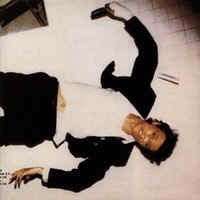
Lodger - 1979
On the surface, Lodger is the most accessible of the three Berlin-era records David
Bowie made with Brian Eno, simply because there are no instrumentals and there are a
handful of concise pop songs. Nevertheless, Lodger is still gnarled and twisted avant pop;
what makes it different is how it incorporates such experimental tendencies into genuine
songs, something that Low and Heroes purposely avoided. "D.J.," "Look Back
in Anger," and "Boys Keep Swinging" have strong melodic hooks that are
subverted and strengthened by the layered, dissonant productions, while the remainder of
the record is divided between similarly effective avant pop and ambient instrumentals.
Lodger has an edgier, more minimalistic bent than its two predecessors, which makes it
more accessible for rock fans, as well as giving it a more immediate, emotional impact. It
might not stretch the boundaries of rock like Low and Heroes, but it arguably utilizes
those ideas in a more effective fashion. - Stephen Thomas Erlewine
01 - (3:02) Fantastic Voyage
02 - (3:02) African Night Flight
03 - (3:25) Move On
04 - (4:17) Yassassin (Turkish For: Long Live)
05 - (3:51) Red Sails
06 - (4:06) DJ
07 - (7:02) Look Back In Anger
08 - (3:24) Boys Keep Swinging
09 - (3:05) Repetition
10 - (4:24) Red Money
11 - (4:00) I Pray Olé
12 - (7:00) Look Back In Anger [New Version Recorded 1988]

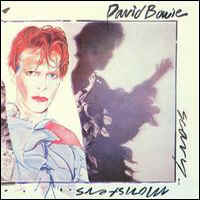
Scary Monsters - 1980
David Bowie returned to relatively conventional rock & roll with Scary Monsters, an
album that effectively acts as an encapsulation of all his '70s experiments. Reworking
glam rock themes with avant-garde synth flourishes, and reversing the process as well,
Bowie creates dense but accessible music throughout Scary Monsters. Though it doesn't have
the vision of his other classic records, it wasn't designed to break new ground - it was
created as the culmination of Bowie's experimental genre-shifting of the '70s. As a
result, Scary Monsters is Bowie's last great album. While the music isn't far removed from
the post-punk of the early '80s, it does sound fresh, hip, and contemporary, which is
something Bowie lost over the course of the '80s. [Rykodisc's 1992 reissue includes
re-recorded versions of "Space Oddity" and "Panic in Detroit," the
Japanese single "Crystal Japan," and the British single "Alabama
Song."] - Stephen Thomas Erlewine
01 - (4:23) It's No Game (Part 1)
02 - (3:18) Up The Hill Backwards
03 - (5:16) Scary Monsters (And Super Creeps)
04 - (4:28) Ashes To Ashes
05 - (4:52) Fashion
06 - (7:00) Teenage Wildlife
07 - (3:38) Scream Like A Baby
08 - (3:48) Kingdom Come
09 - (4:57) Because You're Young
10 - (4:25) It's No Game (Part 2)


Let's Dance - 1983
After summing up his maverick tendencies on Scary Monsters, David Bowie aimed for the
mainstream with Let's Dance. Hiring Chic bassist Nile Rodgers as a co-producer, Bowie
created a stylish, synthesized post-disco dance music that was equally informed by classic
soul and the emerging new romantic subgenre of new wave, which was ironically heavily
inspired by Bowie himself. Let's Dance comes tearing out of the date, propulsed by the
skittering "Modern Love," the seductively menacing "China Girl," and
the brittle funk of the title track. All three songs became international hits, and for
good reason - they're catchy, accessible pop songs that have just enough of an alien edge
to make them distinctive. However, that careful balance is quickly thrown off by a
succession of pleasant but unremarkable plastic soul workouts. "Cat People" and
a cover of Metro's "Criminal World" are relatively strong songs, but the
remainder of the album indicates that Bowie was entering a songwriting slump. However, the
three hits were enough to make the album a massive hit, and their power hasn't diminished
over the years, even if the rest of the record sounds like an artifact. - Stephen Thomas
Erlewine
1 - (4:50) Modern Love
2 - (5:35) China Girl
3 - (7:40) Let's Dance
4 - (3:11) Without You
5 - (5:16) Ricochet
6 - (4:27) Criminal World
7 - (5:12) Cat People (Putting Out Fire)
8 - (3:52) Shake It

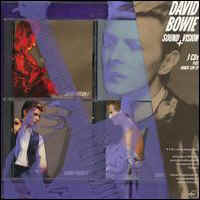
Sound + Vision - 1989
In 1989, not all major artists had their catalog available on CD, and one of the most
notable absences was David Bowie. When the format was in its infancy, RCA had issued
several of his classics, but those pressings were notoriously awful and were pulled from
the market in 1985 when Bowie acquired the rights to the recordings. Sharp businessman
that he is, he took the catalog to market, and after an intense bidding war, he chose to
reissue his classic work through Rykodisc, an independent CD-only label that had earned
acclaim for its work with Frank Zappa's catalog. Instead of dumping all the discs on the
market at once, the titles were slowly rolled out, beginning with a series-encompassing
Sound + Vision, a three-CD/one-CD-ROM box set released to great fanfare in the fall of
1989. At the time, box sets were all the rage, following the template of Bob Dylan's
Biograph - an exhaustive career overview that offered all the basics, peppered with some
revealing rarities. Upon its release, Sound + Vision was reviewed as if it belonged to
this tradition, when it really inverted the formula, offering a series, not career,
overview by showcasing alternate versions and rarities, along wtih album tracks, with a
few familiar hits tossed in here and there to provide context. This was a tantalizing way
to begin a reissue campaign, and it did receive gushing reviews - the CD-era publication
Rock & Roll Disc breathlessly claimed "Suffice to say that the sound quality will
give your ears an orgasm" - but once the reissue series completed and once Ryko lost
the rights to the catalog, Sound + Vision looked more like a curiosity, an artifact of its
time, than a major statement.Much of the problem stems from its design - it was intended
to show off the sound quality, which was a marked improvement over the RCA discs, and to
show the depth and breadth of rarities within the vaults. It was not a career-capper; it
was a teaser. It was enticing upon its release, and some of it remains remains so. There's
a clutch of early rarities that lead off the set - the original demo of "Space
Oddity," alternate single versions of "The Wild-Eyed Boy From Freecloud"
and "The Prettiest Star" - that are quite good, alternate takes on "John
I'm Only Dancing" and "Rebel Rebel" that manage to be notably different
without changing the feel, excellent outtakes from Diamond Dogs (a medley of
"1984/Dodo"), Station to Station (a glittery, lush cover of Springsteen's
"It's Hard to Be a Saint in the City"), and Young Americans (the superb
"After Today," a disco-rock song that should have been on the album and is hands
down the best rarity here). These suggested the great uneathed treasures that lay ahead,
and they remain necessary additions to any serious Bowie collection, particularly because
they never showed up on another disc. If they were placed in a better forum, they would
function like the rarities on either Biograph or Eric Clapton's Crossroads - rarities that
helped fill in the details of an artist's story - but since they're in a set that's
intended to showcase what the Ryko series would do, not what Bowie had done, they're the
main attraction instead of feeding into the greater narrative. And that narrative, while
certainly capturing the sometimes bewildering twists and turns in Bowie's career, is an
alternate-universe narrative, lacking defining songs, from "Starman" to
"Golden Years," and presenting many familiar songs in odd, not particularly
interesting variations (a live 1974 version of "Suffragette City," a German
version of "Heroes," presented in a 1989 remix). Though it succeeds in conveying
Bowie's ever-changing moods, it lacks the substance and sense of a great box set, which
this surely could have been. Instead, it's an interesting artifact of the early days of
CDs, right down to its overly elaborate packaging, and only those who want to relive that
time, or need those rarities, will need this in their collection. - Stephen Thomas
Erlewine
Disc 1
01 - (5:12) Space Oddity
02 - (4:53) Wild-Eyed Boy From Freecloud
03 - (3:13) The Prettiest Star [Single Version]
04 - (2:37) London Bye Ta-Ta
05 - (3:35) Black Country Rock
06 - (3:59) The Man Who Sold The World
07 - (5:25) The Bewlay Brothers
08 - (3:37) Changes
09 - (2:43) Round And Round
10 - (4:41) Moonage Daydream
11 - (2:45) John, I'm Only Dancing
12 - (4:38) Drive-In Saturday
13 - (4:27) Panic In Detroit
14 - (3:18) Ziggy Stardust
15 - (3:59) White Light - White Heat [Live]
16 - (4:33) Rock 'N' Roll Suicide [Live]
Disc 2
01 - (3:10) Anyway, Anyhow, Anywhere
02 - (2:55) Sorrow
03 - (2:09) Don't Bring Me Down
04 - (5:32) 1984 - Dodo
05 - (3:23) Big Brother
06 - (3:03) Rebel Rebel
07 - (3:53) Suffragette City
08 - (5:10) Watch That Man
09 - (3:32) Cracked Actor
10 - (5:14) Young Americans
11 - (5:48) Fascination
12 - (3:52) After Today
13 - (3:51) It's Hard To Be A Saint In The City
14 - (5:34) TVC15
15 - (6:01) Wild Is The Wind
Disc 3
01 - (3:07) Sound And Vision
02 - (2:59) Be My Wife
03 - (2:49) Speed Of Life
04 - (3:42) Helden
05 - (3:09) Joe The Lion
06 - (3:21) Sons Of The Silent Age
07 - (8:54) Station To Station
08 - (6:55) Warszawa
09 - (3:38) Breaking Glass
10 - (3:47) Red Sails
11 - (3:09) Look Back In Anger
12 - (3:20) Boys Keep Swinging
13 - (3:17) Up The Hill Backwards
14 - (3:47) Kingdom Come
15 - (4:26) Ashes To Ashes
Plus
01 - (2:44) John, I'm Only Dancing [Live]
02 - (3:24) Changes [Live]
03 - (2:48) The Supermen [Live]
04 - (3:37) Ashes To Ashes [Dub]

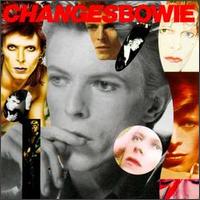
ChangesBowie - 1990
Changesbowie is a CD greatest-hits collection that revamps the original Changesonebowie
by adding selections from David Bowie's late-'70s and early-'80s albums. Consequently, it
functions as a definitive single-disc introduction to Bowie, featuring all of his major
hits from "Space Oddity," "Changes," "Ziggy Stardust,"
"Jean Genie," and "Rebel Rebel" to "Heroes," "Ashes to
Ashes," "Let's Dance," "Modern Love," and "Blue Jean."
One complaint: It wasn't necessary to substitute the "Fame '90" remix for the
original to hook completists, since it is inferior and was already issued as a separate
single. - Stephen Thomas Erlewine
01 - (5:17) Space Oddity
02 - (2:50) John, I'm Only Dancing
03 - (3:38) Changes
04 - (3:14) Ziggy Stardust
05 - (3:29) Suffragette City
06 - (4:10) The Jean Genie
07 - (6:08) Diamond Dogs
08 - (4:33) Rebel Rebel
09 - (5:14) Young Americans
10 - (3:42) Fame 90 [Remix]
11 - (4:02) Golden Years
12 - (3:39) Heroes
13 - (4:27) Ashes To Ashes
14 - (4:50) Fashion
15 - (4:12) Let's Dance
16 - (4:19) China Girl
17 - (4:00) Modern Love
18 - (3:12) Blue Jean


Singles Collection - 1999
Disc 1
01 - (5:20) Space Oddity
02 - (3:39) Changes
03 - (4:22) Starman
04 - (3:18) Ziggy Stardust
05 - (3:30) Suffragette City
06 - (2:51) John, I'm Only Dancing
07 - (4:12) The Jean Genie
08 - (4:34) Drive-In Saturday
09 - (3:56) Life On Mars?
10 - (2:58) Sorrow
11 - (4:35) Rebel Rebel
12 - (3:02) Rock & Roll Suicide
13 - (6:09) Diamond Dogs
14 - (3:07) Knock On Wood
15 - (5:16) Young Americans
16 - (4:19) Fame
17 - (4:04) Golden Years
18 - (5:36) TVC 15
19 - (3:05) Sound And Vision
Disc 2
01 - (3:42) Heroes
02 - (3:38) Beauty And The Beast
03 - (3:22) Boys Keep Swinging
04 - (4:05) DJ
05 - (3:56) Alabama Song
06 - (4:28) Ashes To Ashes
07 - (4:52) Fashion
08 - (5:16) Scary Monsters (And Super Creeps)
09 - (4:01) Under Pressure
10 - (6:06) Wild Is The Wind
11 - (4:15) Let's Dance
12 - (4:21) China Girl
13 - (4:02) Modern Love
14 - (3:15) Blue Jean
15 - (3:54) This Is Not America
16 - (3:15) Dancing In The Street
17 - (5:42) Absolute Beginners
18 - (4:14) Day-In Day-Out

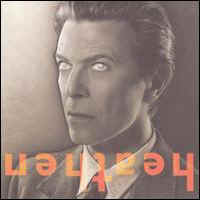
Heathen - 2002
Heathen marks a new beginning for David Bowie in some ways - it's his first record
since leaving Virgin, his first for Columbia Records, his first for his new label, ISO -
yet it's hardly a new musical direction. Like Hours, this finds Bowie sifting through the
sounds of his past, completely at ease with his legacy, crafting a colorful, satisfying
album that feels like a classic Bowie album. That's not to say that Heathen recalls any
particular album or any era in specific, yet there's a deliberate attempt to recapture the
atmosphere, the tone of his '70s work - there's a reason that Bowie decided to reteam with
Tony Visconti, the co-producer of some of his best records, for this album - even if
direct comparisons are hard to come by. Which is exactly what's so impressive about this
album. Bowie and Visconti never shy away from electronic instrumentations or modern
production - if anything, they embrace it - but it's woven into Bowie's sound subtly,
never drawing attention to the drum loops, guitar synths, and washes of electronica. For
that matter, guest spots by Dave Grohl and Pete Townshend (both on guitar) don't stand out
either; they're merely added texture to this an album that's intricately layered, but
always plays smoothly and alluringly. And, make no mistake, this is an alluring,
welcoming, friendly album - there are some moody moments, but Bowie takes Neil Young's
eerie "I've Been Waiting for You" and Pixies' elusively brutal, creepy
"Cactus" and turns them sweet, which isn't necessarily a bad thing, either. In
the end, that's the key to Heathen - the undercurrent of happiness, not in the lyrics, but
in the making of music, a realization by Bowie and Visconti alike that they are perfect
collaborators. Unlike their previous albums together, this doesn't boldly break new
ground, but that's because, 22 years after their last collaboration, Scary Monsters, both
Bowie and Visconti don't need to try as hard, so they just focus on the craft. The result
is an understated, utterly satisfying record, his best since Scary Monsters, simply
because he'd never sounded as assured and consistent since. - Stephen Thomas Erlewine
01 - (4:47) Sunday
02 - (2:56) Cactus
03 - (6:07) Slip Away
04 - (4:44) Slow Burn
05 - (3:30) Afraid
06 - (3:03) I've Been Waiting For You
07 - (5:16) I Would Be Your Slave
08 - (4:07) I Took A Trip On A Gemini Spaceship
09 - (5:03) 5.15 The Angels Have Gone
10 - (4:05) Everyone Says 'Hi'
11 - (4:11) A Better Future
12 - (4:17) Heathen (The Rays)

|